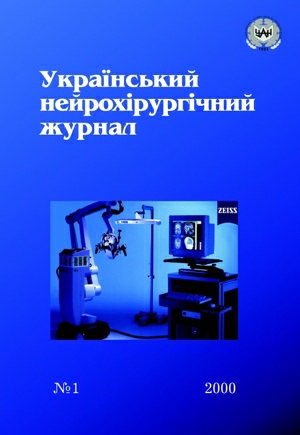Clinical and computer tomographіс features of anterior circulation arterial aneurysms ruptures
Keywords:
aneurysm rupture, anterior arterial circle of the cerebrum, clinical manifestations, CTAbstract
238 patients with arterial aneurysms ruptures of anterior circulation were presented. Clinical and CT manifestation depend of aneurysms localisation, brain compression and delyed ischemia development. Aneurysms ruptures of internal carotid artery supraclinoid part have specific features—absence of deep conscious disturbance—in 82,8%, absence of primary motor deficits in 78,2% patients, delyed ischemia—in 29,9%. Aneurysms ruptures of middle cerebral artery have specific features—primary motor deficits in 64,4% patients, delyed ischemia—in 44,1%, absence of deep conscious disturbance—in 83,1%, convulsive syndrom—in 35,6%. Aneurysms ruptures of anterior cerebral artery and anterior communicate artery have specific features—absence of deep conscious disturbance—in 75%, absence of primary motor deficits in 78,3%, delyed ischemia—in 30,4%.
References
1. Lebedev VV, Miatchin My, Negretsky AP. [The clinical picture of hemorrhages as a consequence of the rupture of cerebral arterial aneurysms]. Zh Vopr Neirokhir Im N N Burdenko.1991;1:6-9. Russian. [PubMed]
2. Bassi P, Bandera R, Loiero M, Tognoni G, Mangoni A. Warning signs in subarachnoid hemorrhage: a cooperative study. Acta Neurol Scand. 1991;84(4):277-81. [PubMed] [CrossRef]
3. Broderick JP, Brott T, Tomsick T, Miller R, Huster G. Intracerebral hemorrhage more than twice as common as subarachnoid hemorrhage. J Neurosurg. 1993;78(2):188-91. [PubMed] [CrossRef]
4. Davis PH, Hachinski V. Epidemiology of cerebrovascular disease. In: Anderson DW, editor. Neuroepidemiology. A Tribute to Bruce Schoenberg. Boca Rotan, Fla: CRC Press, Inc.; 1991. p.141-68.
5. Drake CG. Report of a World Federation of Neurological Surgeons Committee on a Universal Subarachnoid Hemorrhage Grading Scale. J Neurosurg. 1988;68(6):985-6. [PubMed] [CrossRef]
6. Fazl M, Houlden DA, Weaver K. Correlation between cerebral blood flow, somatosensory avoked potentials, CT scan grade and neurological gradein patients with subarachnoid hemorrhage. Can J Neurol Sci. 1991;18(4):453-7. [PubMed]
7. Hernesniemi J, Vapalahti M, Niskanen M, Tapaninaho A, Kari A, Luukkonen M, Puranen M, Saari T, Rajpar M. One-year outcome in early aneurysm surgery: a 14 years experience. Acta Neurochir. 1993;122(1-2):1-10. [PubMed] [CrossRef]
8. Kamitani H, Masuzawa H, Kanazawa I, Kubo T, Tokuyama Y. A long-term follow-up study in direct cerebral aneurysm surgery. Acta Neurochir. 1995;133(3-4):134-40. [PubMed] [CrossRef]
9. Kassell NF, Torner JC, Haley EC Jr., Jane JA, Adams HP, Kongable GL. The International Cooperative Study on the Timing of Aneurysm Surgery: Part 1. Overall management results. J Neurosurg. 1990;73(1):18-36. [PubMed] [CrossRef]
10. Kassell NF, Torner JC, Jane JA, Haley EC Jr., Adams HP. The International Cooperative Study on the Timing of Aneurysm Surgery: Part 2. Surgical results. J Neurosurg. 1990;73(1):37-47. [PubMed] [CrossRef]
Downloads
How to Cite
Issue
Section
License
Copyright (c) 2000 Anatoliy Son

This work is licensed under a Creative Commons Attribution 4.0 International License.
Ukrainian Neurosurgical Journal abides by the CREATIVE COMMONS copyright rights and permissions for open access journals.
Authors, who are published in this Journal, agree to the following conditions:
1. The authors reserve the right to authorship of the work and pass the first publication right of this work to the Journal under the terms of Creative Commons Attribution License, which allows others to freely distribute the published research with the obligatory reference to the authors of the original work and the first publication of the work in this Journal.
2. The authors have the right to conclude separate supplement agreements that relate to non-exclusive work distribution in the form of which it has been published by the Journal (for example, to upload the work to the online storage of the Journal or publish it as part of a monograph), provided that the reference to the first publication of the work in this Journal is included.









